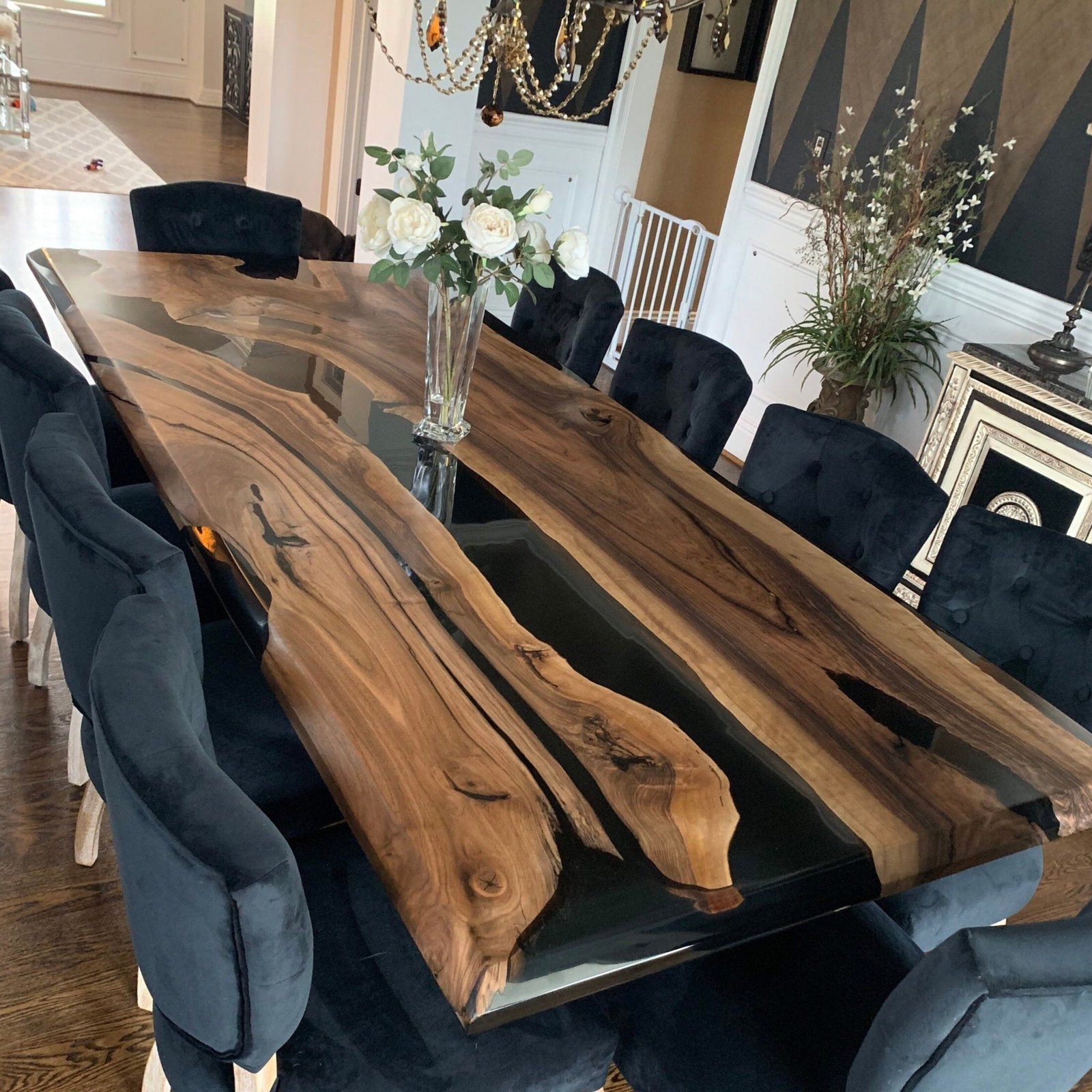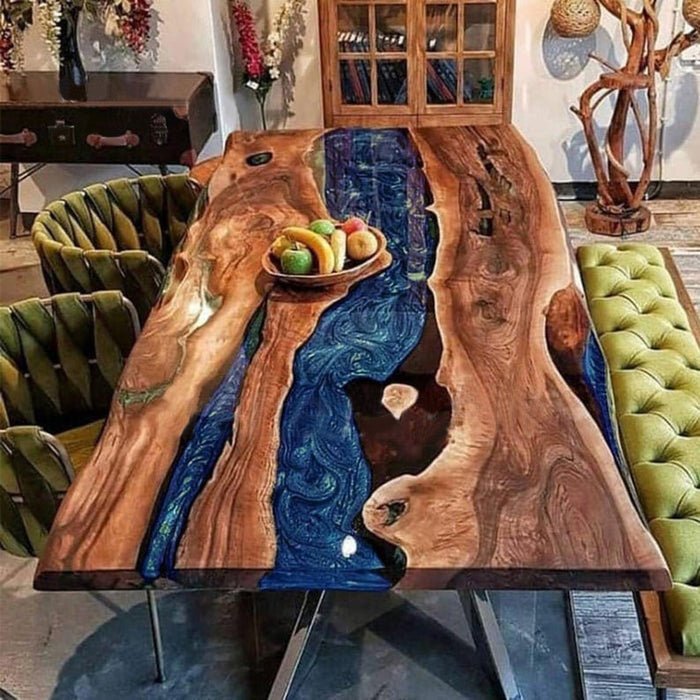Epoxy tables have gained popularity for their unique design and durability. Whether you’re looking to add a statement piece to your living room or find a one-of-a-kind dining table, selecting the right epoxy table requires careful consideration. Here’s a guide to help you make an informed decision when purchasing an epoxy table.
Determine the Purpose and Location
First, consider how and where you plan to use the epoxy table. Different uses may require different designs and sizes:
- Dining Table: If you need a dining table, ensure it’s large enough to accommodate family members and guests and is easy to clean.
- Coffee Table: For a coffee table, you might prioritize aesthetics and decorative design.
- Office Desk: For an office desk, functionality and comfort are key considerations.
Choose the Right Size
The size of the epoxy table should match the proportions of the room. Before purchasing, measure the space where you plan to place the table to ensure it’s neither too large nor too small. Here are some general guidelines:
- Dining Table: Standard height is 29-31 inches (75-78 cm), with a width depending on seating capacity, typically between 35-47 inches (90-120 cm).
- Coffee Table: The height is usually 16-18 inches (40-45 cm), and the length should match the sofa, generally 35-47 inches (90-120 cm).
Select the Right Wood Type
Epoxy tables combine solid wood with resin to create a unique and durable piece of furniture. The choice of wood greatly influences the table’s appearance and character. Below are the primary wood types offered by Sylva Home for their epoxy tables:
- Black Walnut: Black walnut is renowned for its deep, rich color and striking grain patterns. It’s a durable hardwood that brings an element of luxury and sophistication to any space.
- Walnut: Slightly lighter than black walnut, walnut wood offers warm tones with unique grain patterns. It’s a versatile choice that works well in both contemporary and classic designs.
- Poplar: Poplar is a lighter wood with a straight grain, often showcasing subtle waves. It’s a more economical option that can be stained or finished to suit various styles.
- Olive Wood: Olive wood is known for its stunning, swirling grain patterns and warm, golden to dark brown tones. Its rarity and distinct appearance make it perfect for a standout piece.
- Cunninghamia (Chinese Fir): Cunninghamia is a softwood with a fine, even texture and a pale yellow to light brown color. It’s lightweight yet durable, ideal for creating tables with a natural, rustic charm.
- Ash: Ash wood is typically light in color, ranging from creamy white to light brown, with a straight grain and smooth texture. It’s a versatile and strong hardwood that complements various design aesthetics.
- Zebrawood: Zebrawood is characterized by its dramatic, zebra-like stripes of dark brown and light tan. This exotic wood adds a bold, eye-catching element to any epoxy table, perfect for making a statement.
Pick the Right Resin Color and Effect
Resin is the core material in epoxy tables, and its color and transparency can significantly impact the table’s overall effect. Consider the following:
- Transparency: Clear resin showcases the natural beauty of the wood, ideal for designs that highlight wood grain.
- Color Choices: Resin can be tinted in any color, from deep blues to vibrant reds, allowing you to match the room’s color scheme.
- Special Effects: Additions like metallic powders or glitter can make the table more eye-catching.
Understand the Craftsmanship and Quality
The craftsmanship of an epoxy table directly affects its quality and durability. When buying, inquire about the manufacturer’s process and the materials used:
- Layers and Thickness: The thickness of the resin impacts the table’s durability and stability. High-quality epoxy tables often use multiple layers of resin to ensure scratch resistance and wearability.
- Finishing Details: Check the table’s edge finishing and surface smoothness to ensure there are no bubbles, cracks, or imperfections.
Consider Customization Options
If you can’t find an epoxy table that perfectly meets your needs, customization may be an excellent option. Custom tables allow you to choose the wood type, resin color, size, and design according to your preferences. While custom pieces typically require more time and a higher budget, the result is often more aligned with your personal taste.
Consider Your Budget
The price of epoxy tables varies based on wood type, resin quality, size, and craftsmanship. When setting a budget, consider the following:
- Rarity of Wood: Some rare woods, like black walnut or rosewood, are more expensive.
- Quality of Resin: Higher-quality resin is more durable and thus more costly.
- Design Complexity: The more complex the design, the higher the cost due to the increased craftsmanship required.
Understand After-Sales Service and Warranty
When purchasing an epoxy table, it’s important to understand the after-sales service and warranty provided by the manufacturer or retailer. Quality after-sales support can provide peace of mind, especially with custom products.
- Warranty Period: Check if the product comes with a warranty and what it covers (e.g., cracks, discoloration).
- Return Policy: Understand whether you can return or exchange the product if it doesn’t meet your expectations.
Conclusion
Buying the perfect epoxy table is more than just making a purchase; it involves a comprehensive consideration of design, materials, size, and budget. By carefully considering the factors above, you can find an epoxy table that meets both aesthetic standards and functional needs, adding a unique and comfortable touch to your living space.
Whether you’re adding a stunning dining table to your home or a stylish desk to your office, making a thoughtful choice will ensure your epoxy table remains beautiful and functional for years to come.


